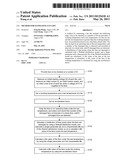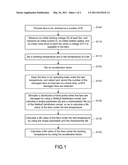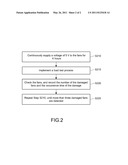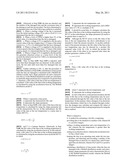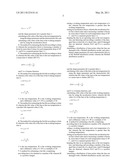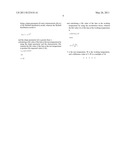Patent application title: METHOD FOR ESTIMATING FAN LIFE
Inventors:
Feng-Ku Wang (Taipei, TW)
Feng-Ku Wang (Taipei, TW)
Yi Lun Cheng (Taipei, TW)
Yi Lun Cheng (Taipei, TW)
Assignees:
Inventec Corporation
IPC8 Class: AG06F1900FI
USPC Class:
702 34
Class name: Measurement system in a specific environment mechanical measurement system wear or deterioration evaluation
Publication date: 2011-05-26
Patent application number: 20110125418
Abstract:
A method for estimating a fan life includes the following steps. Fans to
be checked at a number of M are provided. A working temperature and a
test temperature of a fan are set, and the test temperature is greater
than the working temperature. An acceleration factor is set, which has a
fixed value. The fans are kept in an operating state at the test
temperature, and a number of the damaged fans is detected and recorded at
intervals of a check time, until N damaged fans are detected. A
distribution of time points when the fans are damaged is simulated with a
Weibull distribution model, and a shape parameter and a characteristic
life of the Weibull distribution model are calculated. A life value of
the fans at the test temperature is calculated. A life value of the fans
at the working temperature is calculated by using the acceleration
factor.Claims:
1. A method for estimating a fan life, comprising: providing fans to be
checked at a number of M, wherein M is a positive integer; setting a
working temperature and a test temperature of a fan, wherein the test
temperature is greater than the working temperature; setting an
acceleration factor, wherein the acceleration factor has a fixed value;
keeping the fans in an operating state under the test temperature, and
detecting and recording a number of the damaged fans at intervals of a
check time, until N damaged fans are detected, wherein N≧3 and N
is a positive integer; simulating a distribution of time points when the
fans are damaged with a Weibull distribution model, and calculating a
shape parameter (β) and a characteristic life (α) of the
Weibull distribution model, wherein the Weibull distribution model is F
( t ) = 1 - - ( t α ) β ##EQU00006## and
the shape parameter (β) is greater than 1; calculating a life value
of the fans at the test temperature by using the shape parameter and the
characteristic life; and calculating a life value of the fans at the
working temperature by using the acceleration factor.
2. The method for estimating the fan life according to claim 1, wherein the acceleration factor is increasing a number of hours by more than D times for each temperature drop of 10.degree. C., and D is a numeral greater than 1.1.
3. The method for estimating the fan life according to claim 2, wherein the life value of the fans at the test temperature is a mean time to failure (MTTF), MTTF = α × Γ ( 1 + 1 β ) ##EQU00007## and Γ is a Gamma function.
4. The method for estimating the fan life according to claim 3, wherein a life value (A) of the fans at the working temperature is A=MTTF×(1.5).sup.φ where φ = ( T - W 10 ) ##EQU00008## T is the test temperature, W is the working temperature, and a difference value of T-W is a multiple of 10.
5. The method for estimating the fan life according to claim 2, wherein the life value of the fans at the test temperature is a product life expected value (L10), L10=α×(0.10536).sup.μ and μ=1/β
6. The method for estimating the fan life according to claim 5, wherein a life value (B) of the fans at the working temperature is B=L.sub.10.times.(1.5).sup.φ where φ = ( T - W 10 ) ##EQU00009## T is the test temperature, W is the working temperature, and a difference value of T-W is a multiple of 10.
7. A method for estimating a fan life, comprising: providing fans to be checked at a number of M, wherein M is a positive integer; setting a working temperature and a test temperature of a fan, wherein the test temperature is greater than the working temperature; setting an acceleration factor, wherein the acceleration factor has a fixed value and is increasing a number of hours by more than D times for each temperature drop of 10.degree. C., and D is a numeral greater than 1.1; keeping the fans in an operating state at the test temperature, and detecting and recording a number of the damaged fans at intervals of a check time, until N damaged fans are detected, wherein N≧3 and N is a positive integer; simulating a distribution of time points when the fans are damaged with a Weibull distribution model, and calculating a shape parameter (β) and a characteristic life (α) of the Weibull distribution model, wherein the Weibull distribution model is F ( t ) = 1 - - ( t α ) β ##EQU00010## and the shape parameter (β) is greater than 1; calculating a life value of the fans at the test temperature by using the shape parameter and the characteristic life, wherein the life value of the fans at the test temperature is a mean time to failure (MTTF), MTTF = α × Γ ( 1 + 1 β ) ##EQU00011## and Γ is a Gamma function; and calculating a life value of the fans at the working temperature by using the acceleration factor, wherein the life value (A) of the fans at the working temperature is A=MTTF×(1.5).sup.φ where φ = ( T - W 10 ) ##EQU00012## T is the test temperature, W is the working temperature, and a difference value of T-W is a multiple of 10.
8. A method for estimating a fan life, comprising: providing fans to be checked at a number of M, wherein M is a positive integer; setting a working temperature and a test temperature of a fan, wherein the test temperature is greater than the working temperature; setting an acceleration factor, wherein the acceleration factor has a fixed value and is increasing a number of hours by more than D times for each temperature drop of 10.degree. C., and D is a numeral greater than 1.1; keeping the fans in an operating state at the test temperature, and detecting and recording a number of the damaged fans at intervals of a check time, until N damaged fans are detected, wherein N≧3 and N is a positive integer; simulating a distribution of time points when the fans are damaged with a Weibull distribution model, and calculating a shape parameter (β) and a characteristic life (α) of the Weibull distribution model, wherein the Weibull distribution model is F ( t ) = 1 - - ( t α ) β ##EQU00013## and the shape parameter (β) is greater than 1; calculating a life value of the fans at the test temperature by using the shape parameter and the characteristic life, wherein the life value of the fans at the test temperature is product life expected value (L10), L10=α×(0.10536).sup.μ and μ=1/β and calculating a life value of the fans at the working temperature by using the acceleration factor, wherein the life value (A) of the fans at the working temperature is A=MTTF×(1.5).sup.φ where φ = ( T - W 10 ) ##EQU00014## T is the test temperature, W is the working temperature, and a difference value of T-W is a multiple of 10.
Description:
CROSS-REFERENCE TO RELATED APPLICATIONS
[0001] This non-provisional application claims priority under 35 U.S.C. §119(a) on Patent Application No(s). 098140224 filed in Taiwan, R.O.C. on Nov. 25, 2009, the entire contents of which are hereby incorporated by reference.
BACKGROUND OF THE INVENTION
[0002] 1. Field of the Invention
[0003] The present invention relates to a method for estimating a product life, and more particularly to a method for estimating a fan life.
[0004] 2. Related Art
[0005] In recent years, with the rapid progress of computer technology, the operating speed of the computer is continuously increased, and the heat generation rate of electronic elements in the computer also rises accordingly. In order to prevent the electronic elements in the computer from getting overheated to cause a temporary or permanent failure to the electronic elements, a heat dissipation module is placed in the computer in the prior art, so as to dissipate the heat generated by the electronic elements out of the computer.
[0006] In the electronic elements, a central processing unit (CPU) is a main heat generation source among the electronic elements of the computer. When the CPU is operating at a high speed, if the temperature of the CPU exceeds a normal working temperature range, an operation error may easily occur to the CPU, or the CPU is temporarily failed, resulting in a breakdown of the computer. In addition, when the temperature of the CPU far exceeds the normal working temperature range, transistors in the CPU may be easily damaged and cause permanent failure to the CPU.
[0007] Therefore, when the computers are manufactured, in order to ensure a normal operation of the heat dissipation module assembled in the computer within a warranty period, manufacturers of the computers need to accurately estimate a fan life in the heat dissipation modules.
SUMMARY OF THE INVENTION
[0008] In order to solve the above problems, the present invention is a method for estimating a fan life, so as to accurately estimate the fan life.
[0009] The method for estimating a fan life comprises the following steps. Fans to be checked at a number of M are provided, in which M is a positive integer. A working temperature and a test temperature of a fan are set, and the test temperature is greater than the working temperature. An acceleration factor is set, which has a fixed value. The fans are kept in an operating state at the test temperature, and a number of the damaged fans is detected and recorded at intervals of a check time, until N damaged fans are detected, in which N≧0.1M and N is a positive integer. A distribution of time points when the fans are damaged is simulated with a Weibull distribution model, and a shape parameter (β) and a characteristic life (α) of the Weibull distribution model are calculated, in which the Weibull distribution model is
F ( t ) = 1 - - ( t α ) β ##EQU00001##
[0010] A life value of the fans at the test temperature is calculated. A life value of the fans at the working temperature is calculated by using the acceleration factor.
[0011] In view of the above, in the present invention, the life value of the fans at the working temperature may be accurately estimated through the life value of the fans at the test temperature. In this manner, when a designer of an electronic device determines which fan to be adopted through evaluation, the designer may calculate and compare life values of fans of various brands at the working temperature by using the above method.
BRIEF DESCRIPTION OF THE DRAWINGS
[0012] The present invention will become more fully understood from the detailed description given herein below for illustration only, and thus are not limitative of the present invention, and wherein:
[0013] FIG. 1 is a method for estimating a fan life according to an embodiment of the present invention; and
[0014] FIG. 2 is a schematic flow chart of Step S125 in FIG. 1.
DETAILED DESCRIPTION OF THE INVENTION
[0015] FIG. 1 is a method for estimating a fan life according to an embodiment of the present invention. Referring to FIG. 1, firstly, in Step S105, fans to be checked at a number of M are provided, in which M is a positive integer. In this embodiment, the number M of the fans is, for example, 50. Then, in Step S110, an initial starting voltage (X) of each fan is measured. Moreover, in this embodiment, if a voltage of 5 V is supplied to the fans, an initial current (I), an initial rotation speed, and an initial noise level of each fan are measured. In addition, in this embodiment, the fans are driven in a pulse width modulation (PWM) mode by a power supply or a signal generator, and an initial response value generated by each fan to the power supply is measured.
[0016] Afterward, in Step S115, a working temperature (W) and a test temperature (T) are set. The test temperature is greater than the working temperature, and a difference value (T-W) between the test temperature and the working temperature is a multiple of 10. In this embodiment, the working temperature is 60° C., and the test temperature is, for example, a temperature in a range of 80° C. to 100° C.
[0017] Next, in Step S120, an acceleration factor φ is set, which has a fixed value. In this embodiment, the acceleration factor φ is defined to be increasing a number of hours by more than D times for each temperature drop of 10° C., and D is a numeral greater than 1.1, for example, D is 1.5.
[0018] Then, in Step S125, at the test temperature, the fans are kept in an operating state, and a number of the damaged fans is detected and recorded at intervals of a check time, until N damaged fans are detected, in which N≧3 and N is a positive integer, for example, N is 3. The above test method is introduced in detail below. FIG. 2 is a schematic flow chart of Step S125 in FIG. 1. Referring to FIG. 2, firstly, in Step S210, a voltage of 5 V is continuously supplied to the fans for K hours, in which K is a fixed value randomly selected from a range of 200 to 350.
[0019] Next, in Step S215, a load test process is implemented, which comprises the following steps. The fans are driven in the PWM mode, such that the fans perform a load cycle for several times. In each load cycle of this embodiment, a voltage of 5 V is continuously supplied to the fans for 120 seconds, and then the voltage supply is stopped for 10 seconds. In this embodiment, the times of the load cycle is greater than 10.
[0020] Afterward, in Step S220, the fans are checked, and the number of the damaged fans and the occurrence time of the damage to each fan are recorded. The fan is determined to be damaged when one of the following conditions is satisfied.
[0021] a. When a starting voltage of the fan is increased from the initial starting voltage (X) to above (X+0.5) V, it is determined that the fan is damaged;
[0022] b. When a load of PWM is higher than 5% of the initial value, it is determined that the fan is damaged;
[0023] c. When a voltage of 5V is supplied to the fan and a current value of the fan is higher than 1.15 times of the initial current (i.e., 1.151), it is determined that the fan is damaged;
[0024] d. When a voltage of 5V is supplied to the fan and a rotation speed of the fan is higher than 1.15 times of the initial rotation speed, it is determined that the fan is damaged; and
[0025] e. When a voltage of 5V is supplied to the fan and the fan generates abnormal noises or a noise level of the fan exceeds the initial noise level for 3 dBA, it is determined that the fan is damaged.
[0026] Then, in Step S225, Step S210 is repeated, until more than three damaged fans are detected. In this embodiment, the test ends until more than five damaged fans are detected.
[0027] Further referring to FIG. 1, after the procedure of Step 125 is finished, in Step S130, a distribution of time points when the fans are damaged is simulated with a Weibull distribution model, and a shape parameter (β) and a characteristic life (α) of the Weibull distribution model are calculated, in which the shape parameter (β) is required to be greater than 1. Therefore, a life value of the fans at the test temperature is calculated. A life value of the fans at the working temperature is calculated by using the acceleration factor φ. The Weibull distribution model is
F ( t ) = 1 - - ( t α ) β ##EQU00002##
[0028] Where t represents a time point;
[0029] α represents the characteristic life; and
[0030] β represents the shape parameter.
[0031] Next, in Step S135, a life value of the fans at the test temperature is calculated by using the shape parameter (β) and the characteristic life (α). In this embodiment, the life value of the fans at the test temperature is a mean time to failure (MTTF),
MTTF = α × Γ ( 1 + 1 β ) ##EQU00003##
[0032] and Γ is a Gamma function. Afterwards, in Step S140, the life value of the fans at the working temperature is calculated by using the acceleration factor φ. In this embodiment, a life value (A) of the fans at the working temperature is calculated by using the acceleration factor φ and the MTTF, in which
A=MTTF×(1.5).sup.φ
where
φ = ( T - W 10 ) ##EQU00004##
[0033] T represents the test temperature; and
[0034] W represents the working temperature, and a difference value of T-W is a multiple of 10.
[0035] It should be noted that, if a designer calculates the life value of the fans at the working temperature by using the MTTF, in this embodiment, the shape parameter (β) needs to be greater than or equal to 3.
[0036] Although the MTTF serves as the life value of the fans at the test temperature, the above embodiment is not intended to limit the present invention. In another embodiment of the present invention, the life value of the fans at the test temperature may also be denoted by a product life expected value (Life 10, L10), in which the product life expected value (L10) refers to an expected time when the product generates a defect of 10%,
L10=α×(0.10536).sup.μ
and
μ=1/β
[0037] Here, a life value (B) of the fans at the working temperature is:
B=L10×(1.5).sup.φ
in which
φ = ( T - W 10 ) ##EQU00005##
[0038] where T represents the test temperature; and
[0039] W represents the working temperature.
[0040] In view of the above, in the present invention, the life value of the fans at the working temperature may be accurately estimated through the life value of the fans at the test temperature. In this manner, when a designer of an electronic device determines which fan to be adopted through evaluation, the designer may calculate and compare life values of fans of various brands at the working temperature by using the above method.
User Contributions:
Comment about this patent or add new information about this topic:

